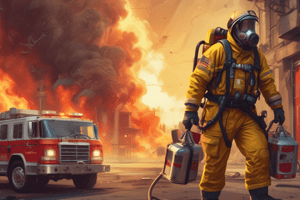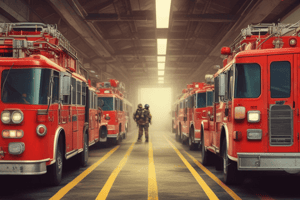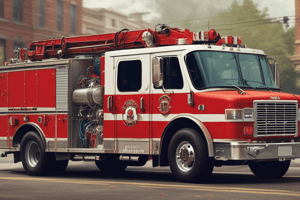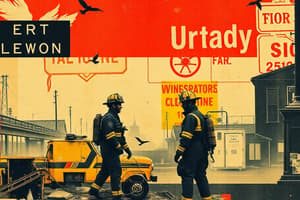Podcast
Questions and Answers
Which of the following is NOT a defensive option in hazmat situations?
Which of the following is NOT a defensive option in hazmat situations?
- Capping the spill (correct)
- Vapor suppression with foam
- Diking
- Covering storm drains
What is the primary objective when initiating defensive operations during a hazmat incident?
What is the primary objective when initiating defensive operations during a hazmat incident?
- Evacuate surrounding areas immediately
- Establish communication with local authorities
- Contain the product and eliminate ignition sources (correct)
- Conduct offensive operations to secure the area
Which action should be taken if it is determined that a hazmat incident is occurring?
Which action should be taken if it is determined that a hazmat incident is occurring?
- Call for the Hazardous Materials Response Team (correct)
- Attempt to clean up the spill yourself
- Start offensive operations immediately
- Seal off the area without precaution
In hazmat defensive measures, what two things can you use hose stream for?
In hazmat defensive measures, what two things can you use hose stream for?
Which of the following defensive options does NOT involve physical barriers?
Which of the following defensive options does NOT involve physical barriers?
What should first-in fire companies do in response to a motor vehicle fluid spill?
What should first-in fire companies do in response to a motor vehicle fluid spill?
In which scenario is Hazmat specifically required to coordinate mitigation activities?
In which scenario is Hazmat specifically required to coordinate mitigation activities?
What should fire companies do if they cannot locate the spiller or property owner of a hazardous material?
What should fire companies do if they cannot locate the spiller or property owner of a hazardous material?
What action should fire companies take to prevent hazardous spills from entering drainage systems?
What action should fire companies take to prevent hazardous spills from entering drainage systems?
What is the role of fire companies concerning emulsification of hazardous materials?
What is the role of fire companies concerning emulsification of hazardous materials?
What is the recommended approach for a fire company responding to a hazardous materials incident?
What is the recommended approach for a fire company responding to a hazardous materials incident?
Which type of information should be prioritized in route to a hazardous materials scene?
Which type of information should be prioritized in route to a hazardous materials scene?
What is a key step if the identity of the hazardous material cannot be determined?
What is a key step if the identity of the hazardous material cannot be determined?
What resource should responders utilize to lookup information on hazardous materials upon arrival?
What resource should responders utilize to lookup information on hazardous materials upon arrival?
Which of the following is NOT recommended when establishing a command post at a hazardous materials incident?
Which of the following is NOT recommended when establishing a command post at a hazardous materials incident?
What should responders look for to assist in identifying the hazardous material involved?
What should responders look for to assist in identifying the hazardous material involved?
What info does guide pages NOT give?
What info does guide pages NOT give?
Which factor should responders maintain awareness of while responding to a hazardous materials incident?
Which factor should responders maintain awareness of while responding to a hazardous materials incident?
What entities must be notified when ant product(raw,emulsified,neutralized) regardless of size enters or threatens to enter the sewer(sanitary or storm) or a waterway?
What entities must be notified when ant product(raw,emulsified,neutralized) regardless of size enters or threatens to enter the sewer(sanitary or storm) or a waterway?
Who is responsible for contacting a remediation company if the spiller is unknown?
Who is responsible for contacting a remediation company if the spiller is unknown?
What must a remediation company be in order to be selected for a hazardous material spill?
What must a remediation company be in order to be selected for a hazardous material spill?
What role does the spiller have regarding the selection of a remediation company?
What role does the spiller have regarding the selection of a remediation company?
Which of these actions is prohibited for members of the Tulsa Fire Department?
Which of these actions is prohibited for members of the Tulsa Fire Department?
What is the fiscal responsibility of the spiller in case of a hazardous materials incident?
What is the fiscal responsibility of the spiller in case of a hazardous materials incident?
What must be verified before allowing outside agency personnel into the incident area?
What must be verified before allowing outside agency personnel into the incident area?
What is the primary role of Hazmat in spill incidents?
What is the primary role of Hazmat in spill incidents?
What is the primary action to take if a responder is contaminated upon arrival?
What is the primary action to take if a responder is contaminated upon arrival?
Which method is NOT recommended for isolating a contaminated area?
Which method is NOT recommended for isolating a contaminated area?
What does the highlighting of a product name in the ERG yellow or blue bordered pages indicate?
What does the highlighting of a product name in the ERG yellow or blue bordered pages indicate?
Which of the following actions should NOT be taken when evaluating hazards?
Which of the following actions should NOT be taken when evaluating hazards?
How should emergency responders approach blocking the extension of hazardous materials?
How should emergency responders approach blocking the extension of hazardous materials?
What is the purpose of establishing separate holding areas for contaminated individuals?
What is the purpose of establishing separate holding areas for contaminated individuals?
What should be done if employees or citizens are in the contamination area?
What should be done if employees or citizens are in the contamination area?
Which resource should be utilized to look up information on control zones?
Which resource should be utilized to look up information on control zones?
If the product name is highlighted in the yellow or blue bordered pages of bordered pages refer to what first?
If the product name is highlighted in the yellow or blue bordered pages of bordered pages refer to what first?
Who can you use to secure control zones?
Who can you use to secure control zones?
Are fire companies allowed to transport contaminated or hazardous materials
Are fire companies allowed to transport contaminated or hazardous materials
What can fire companies use to control flammability hazards if deemed necessary?
What can fire companies use to control flammability hazards if deemed necessary?
If it is safe to do so (per erg or hazmat direction) use defensive control measures to contain the product and eliminate ______
If it is safe to do so (per erg or hazmat direction) use defensive control measures to contain the product and eliminate ______
The actual contact must be carried out by the _____
The actual contact must be carried out by the _____
For large quantity hydrocarbon spills, the -_ _____ will coordinate mitigation and remediation activities with the IC
For large quantity hydrocarbon spills, the -_ _____ will coordinate mitigation and remediation activities with the IC
While responding to the incident obtain as much info as possible from FAO. Keep in mind weather info comes from Tulsa international airport: wind ___ and ___, ___ of hazardous material involved, physical ____ of the material.
While responding to the incident obtain as much info as possible from FAO. Keep in mind weather info comes from Tulsa international airport: wind ___ and ___, ___ of hazardous material involved, physical ____ of the material.
Isolate the area by setting up a ___ zone. Deny entry to non emergency responders. Use barrier ___, rope or natrual barriers to keep civilians and FFs out of the contaminated area
Isolate the area by setting up a ___ zone. Deny entry to non emergency responders. Use barrier ___, rope or natrual barriers to keep civilians and FFs out of the contaminated area
For large quantity hydrocarbon spills, the hazmat ____ will coordinate mitigation and _____ activities with the ic
For large quantity hydrocarbon spills, the hazmat ____ will coordinate mitigation and _____ activities with the ic
Flashcards
Hazardous Materials Response Overview
Hazardous Materials Response Overview
The guidelines outlining Tulsa Fire Department's (TFD) response to hazardous material emergencies, prioritizing safety and proper procedures for incident management.
Upwind/Uphill/Upstream Approach
Upwind/Uphill/Upstream Approach
Approaching a hazardous material incident from a safe vantage point, upwind, uphill, and upstream, to minimize exposure.
Critical Information from FAO
Critical Information from FAO
Critical information obtained from the Fire Alarm Office (FAO) that informs safe response strategies.
Arrival at Scene
Arrival at Scene
Signup and view all the flashcards
Identifying Hazardous Material
Identifying Hazardous Material
Signup and view all the flashcards
Treating Unknown Material
Treating Unknown Material
Signup and view all the flashcards
Isolation Area
Isolation Area
Signup and view all the flashcards
Access Restriction
Access Restriction
Signup and view all the flashcards
Safe Holding Area
Safe Holding Area
Signup and view all the flashcards
Exposure Evaluation
Exposure Evaluation
Signup and view all the flashcards
Emergency Response Guidebook (ERG)
Emergency Response Guidebook (ERG)
Signup and view all the flashcards
Defensive Operations
Defensive Operations
Signup and view all the flashcards
Defensive Techniques
Defensive Techniques
Signup and view all the flashcards
Offensive Actions
Offensive Actions
Signup and view all the flashcards
Notification of Outside Agencies
Notification of Outside Agencies
Signup and view all the flashcards
Notification for Environmental Threats
Notification for Environmental Threats
Signup and view all the flashcards
Remediation Responsibility
Remediation Responsibility
Signup and view all the flashcards
Remediation Contractor Selection
Remediation Contractor Selection
Signup and view all the flashcards
Company Responsibilities in Spills
Company Responsibilities in Spills
Signup and view all the flashcards
Emulsification Protocols
Emulsification Protocols
Signup and view all the flashcards
Preventing Environmental Contamination
Preventing Environmental Contamination
Signup and view all the flashcards
Transporting Contaminated Materials
Transporting Contaminated Materials
Signup and view all the flashcards
Vapor Suppression
Vapor Suppression
Signup and view all the flashcards
Diversion
Diversion
Signup and view all the flashcards
Diking
Diking
Signup and view all the flashcards
Damming
Damming
Signup and view all the flashcards
Emulsification
Emulsification
Signup and view all the flashcards
Fog Streams
Fog Streams
Signup and view all the flashcards
Study Notes
Hazardous Materials Response Overview
- Guidelines established for Tulsa Fire Department (TFD) response to hazardous material emergencies.
- Emphasizes safety and proper procedures for incident management to minimize risk.
Fire Company Response Guidelines
-
Approach/Response
- Plan approach from upwind, uphill, and upstream positions.
- Gather critical information from the Fire Alarm Office (FAO), including:
- Wind speed and direction.
- Type and physical state of hazardous material.
-
Arrival at Scene
- Avoid committing to dangerous situations upon arrival.
- Establish command post and staging area away from hazard zones.
- Identify and confirm the hazardous material using:
- Shipping papers and Material Safety Data Sheets (MSDS).
- Visual identification through placards and container shapes/colors.
- If undetermined, treat the material as highly toxic or volatile.
Control Zone Management
- Set up isolation area to protect non-emergency responders:
- Utilize barrier tape, rope, or natural barriers to restrict access.
- Create safe holding areas for contaminated personnel or victims.
- Evaluate potential exposures based on material movement.
- Use Emergency Response Guidebook (ERG) for establishing control zones.
Defensive Operations
- Initiate defensive measures only when safe to do so:
- Use techniques like damming, diking, diversion, vapor suppression, and fog streams.
- Offensive actions will be handled by the Hazardous Materials Response Team.
Notification of Outside Agencies
- Incident Commander (IC) responsible for notifying external agencies as needed.
- Immediate notification required if hazardous material threatens sewer or waterways.
- Spiller remains responsible for remediation costs and must choose a licensed company.
- TFD personnel cannot select or recommend remediation contractors.
Company Responsibilities in Hazardous Materials Spills
- First-in companies to contain minor spills and request additional resources for larger incidents.
- Emulsification protocols must be followed strictly by Hazmat teams.
- TFD should prevent spills from entering drainage systems or waterways.
- TFD does not transport contaminated materials; coordinated efforts with Hazmat for large spills.
Studying That Suits You
Use AI to generate personalized quizzes and flashcards to suit your learning preferences.




